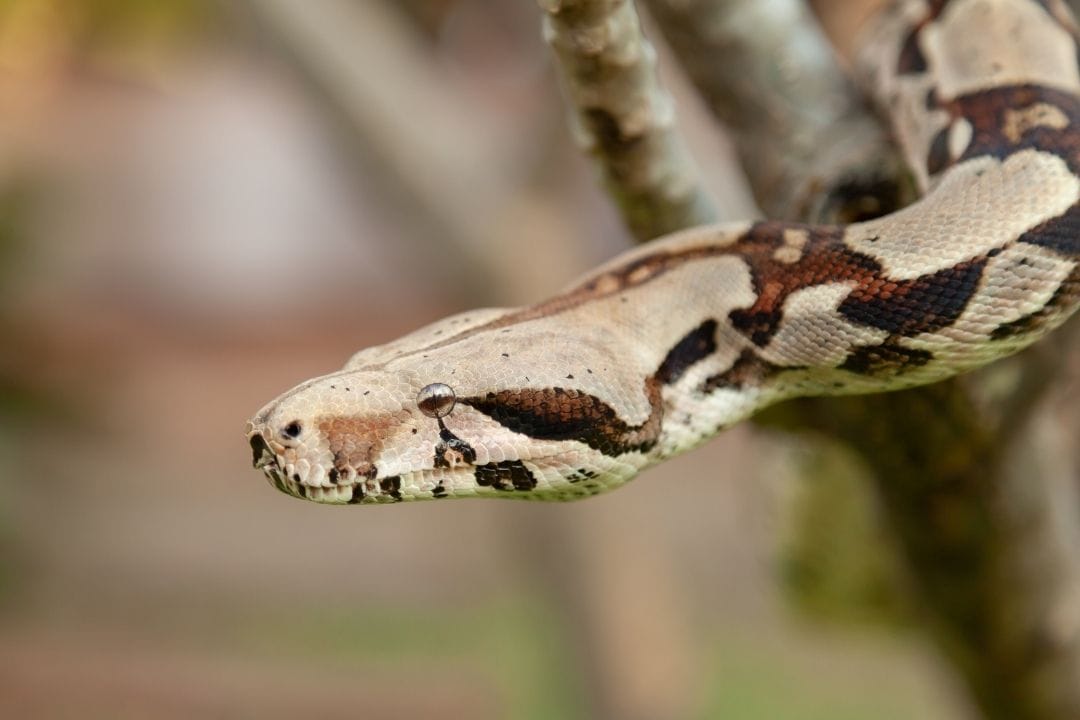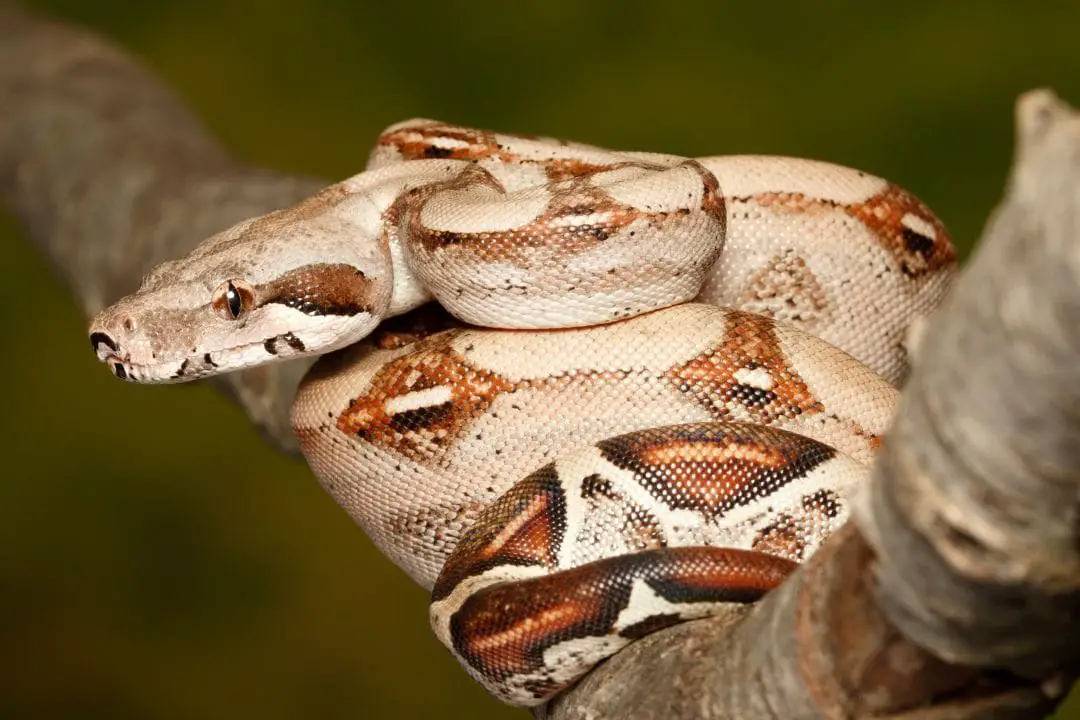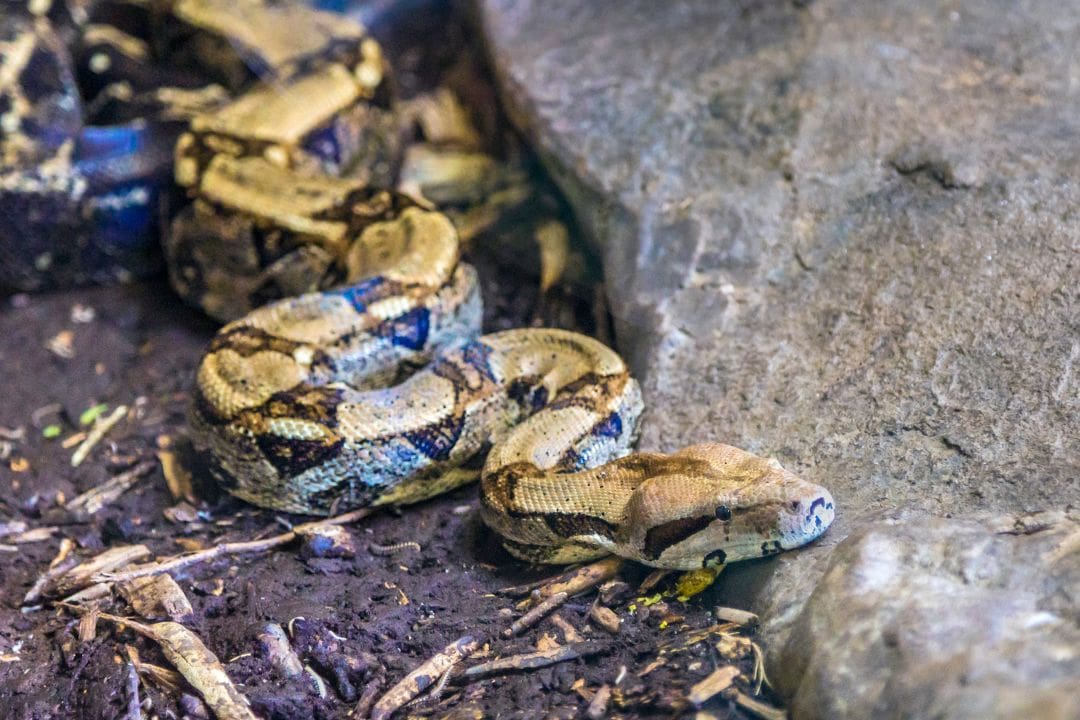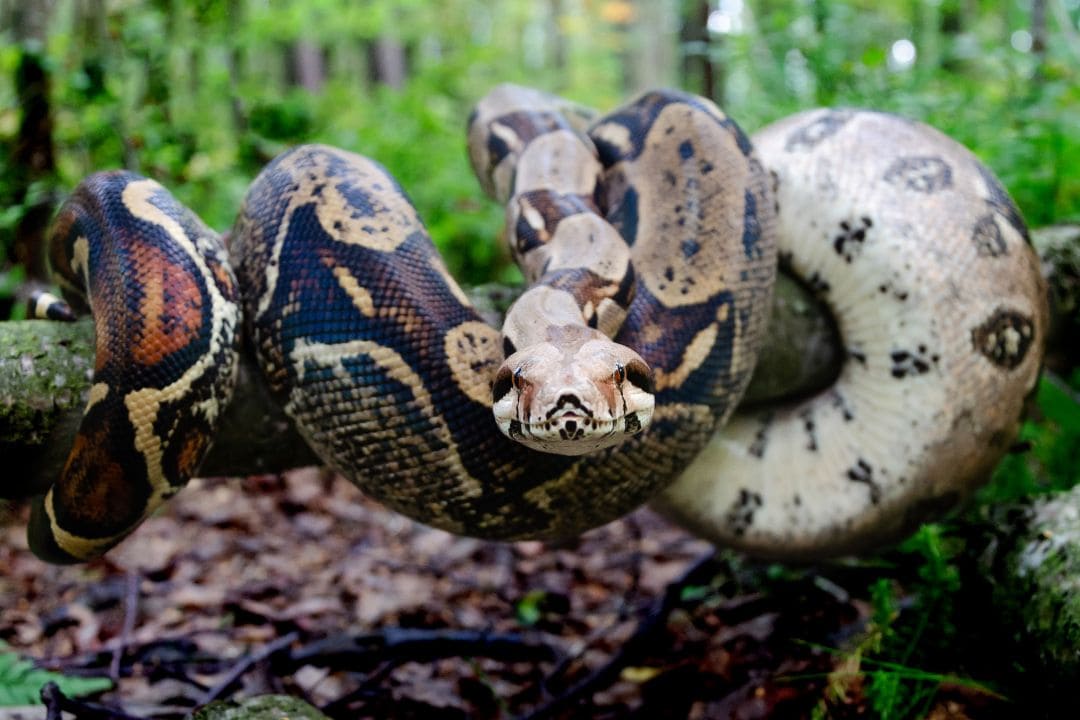The boa constrictor (Boa constrictor) is a very wide-spread non-venomous snake. These animals can be found in central and south america from northern Mexico down to Argentina and Peru.
They are wide-spread, semi-arboreal snakes. They are typically found on the edges of forests but they can be found in many other habitats like grasslands. While they typically eat rodents and birds, they will eat anything they can fit in their mouths.
These snakes are typically found on the ground or partly up trees. They like lots of cover and plenty of climbing options. These snakes are very large, with males topping out at 8 feet depending on the subspecies.
Some females can top 12 feet long, so they will likely end up needing customized caging for the longer individuals. You may also see animals like Boa imperator and Boa sigma sold as boa constrictors since they were once considered subspecies.
If you want a smaller snake, be sure to find the right subspecies for you. This guide will help you learn the best way to care for these amazing animals.
Housing
The goal for housing is to create a slice of your snake’s native habitat. It should allow for plenty of room to fulfill natural behaviors.
There should be hides, perches, the right temperature gradient, and humidity. Your snake will also need plenty of water, provided in a dish.
Enclosure
Boa constrictors need a lot of space. At a minimum, you need the snake to have enough room to stretch out and get exercise. While you may not see your snake move much, once night falls this species is very active.
They will make use of every square inch of space you offer them. They need plenty of perches, levels to rest on, and hides. A few proper hides combined with loose substrate and some partially buried pieces of bark can offer extra hides.
The higher perches should also have some coverage to help the snake feel secure. You should have at least an enclosure where the diagonal measurement from corner to corner is as long as your snake.
Minimum Enclosure Size
Ideally, you should follow the rule of the length of the snake by half that for width and height.
Try to offer at least this much space, but you can give more space to help keep your snake active and healthy.
Enclosure for Juvenile Boa Constrictors
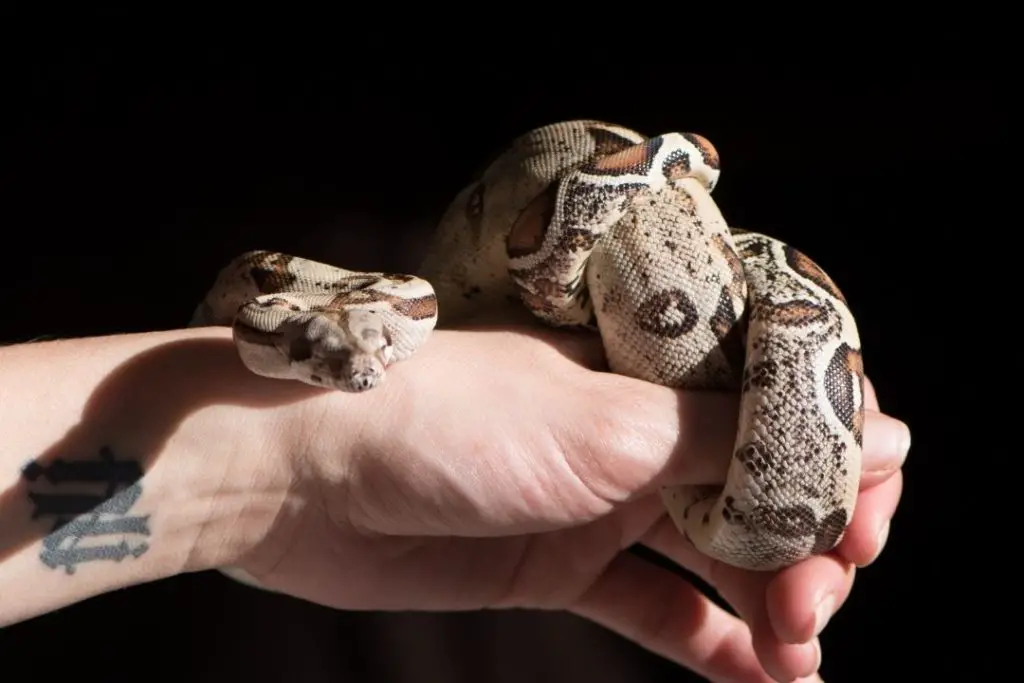
For babies, you need to offer plenty of hides and prepare for future growth. Your boa constrictor will triple in length over its first year of life. Babies under 2 feet can be kept in a cage that is at least 2 feet by 1 foot by 1 foot.
However, once they get over 2 feet you want a cage that is at least 4 feet by 2 feet by 2 feet. This will work for your snake until it is 5 feet in length. For smaller male snakes, this will work until it is an adult.
Custom Reptile Habitats – PVC & Aluminum Enclosure – 48 L x 24 W x 24 H
- Sliding glass doors – Enjoy this big viewing area with crystal clear 1/4 inch Tempered glass that won’t scratch or discolor over time
- Stunning design with super strong Anodized Aluminum frame – Looks great in your home and will never rust or peel
- Real PVC panels – The preferred choice for reptile enclosures. Holds high humidity and will never break, rot or catch fire
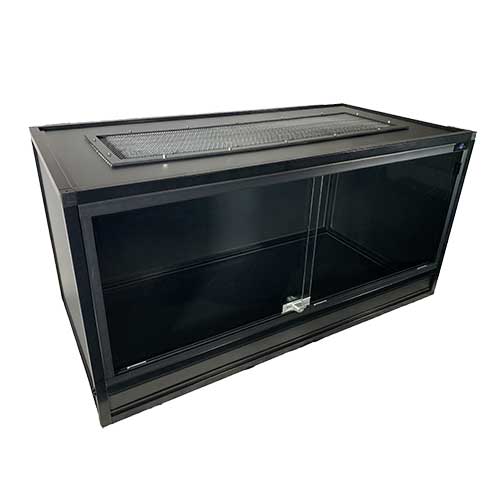
This is a great option for juvenile snakes under 5 feet. It has secure doors and allows you to approach your snake from the side more easily.
Glass aquariums are not recommended as they will require feeding from the top and boas are smart and strong enough to escape them.
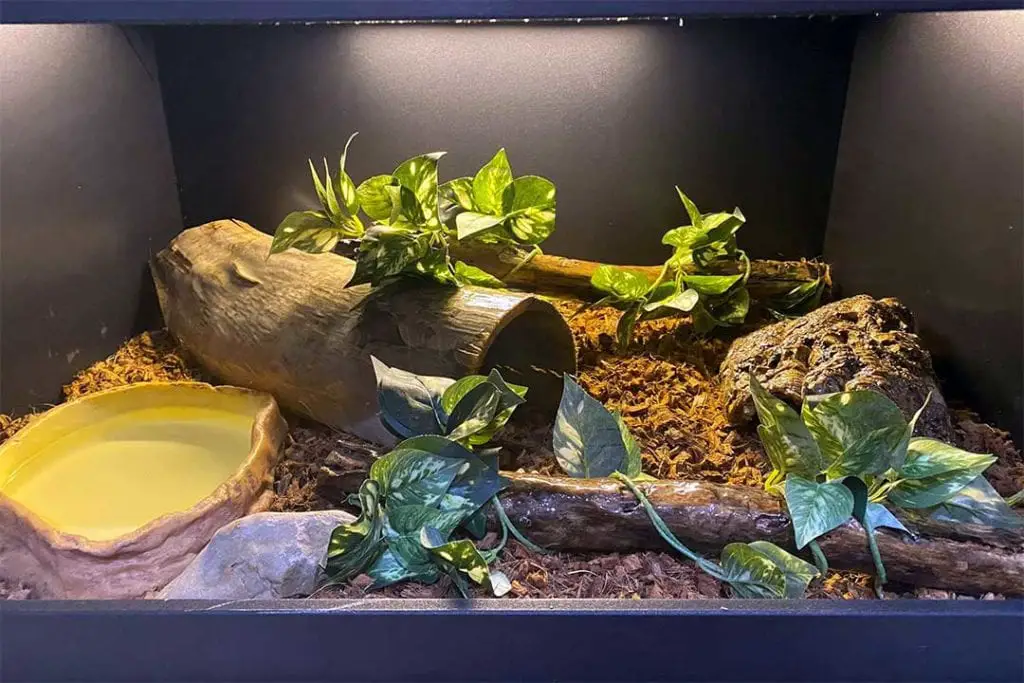
This will work great for young snakes, and you can easily turn this into an enclosure for many other species of adult snake if you decorate it properly.
Enclosure for Adult Boa Constrictors
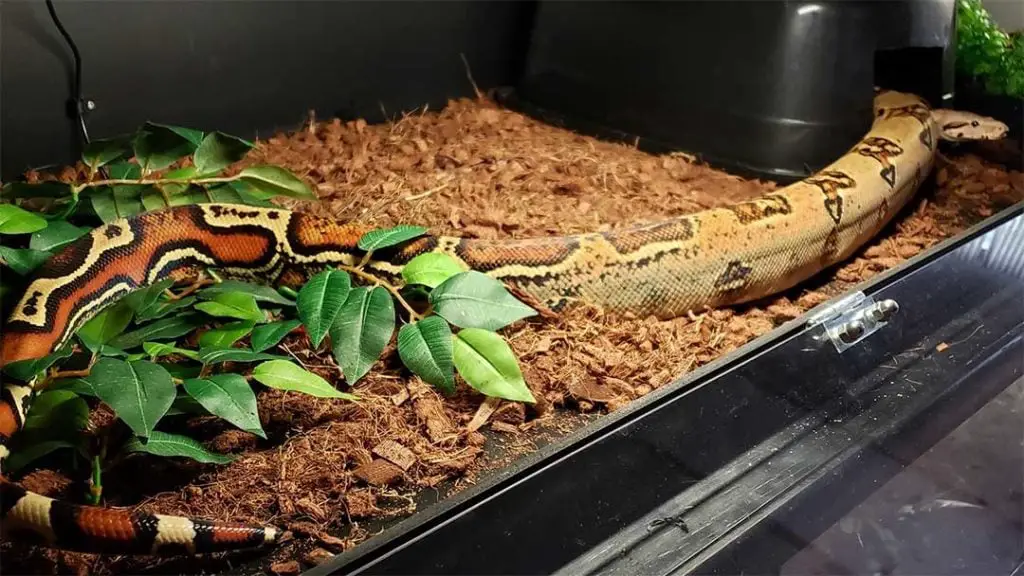
Since adult boas average 5-8 feet for most subspecies, you will need a very big enclosure. Adults under 8 feet need 6 feet by 3 feet by 3 feet as a minimum. This is to help encourage natural hunting and exploring behaviors.
Custom Reptile Habitats – PVC & Aluminum Enclosure – 72 L x 24 W x 36 H
- Sliding glass doors – Enjoy this big viewing area with crystal clear 1/4 inch Tempered glass that won’t scratch or discolor over time
- Stunning design with super strong Anodized Aluminum frame – Looks great in your home and will never rust or peel
- Real PVC panels – The preferred choice for reptile enclosures. Holds high humidity and will never break, rot or catch fire

This is the largest ready-made cage by Custom Reptile Habitats. It should work well for smaller subspecies such as the Bolivian shot tailed boa or other members of the Boa genus like the Central American or Sonoran boa.
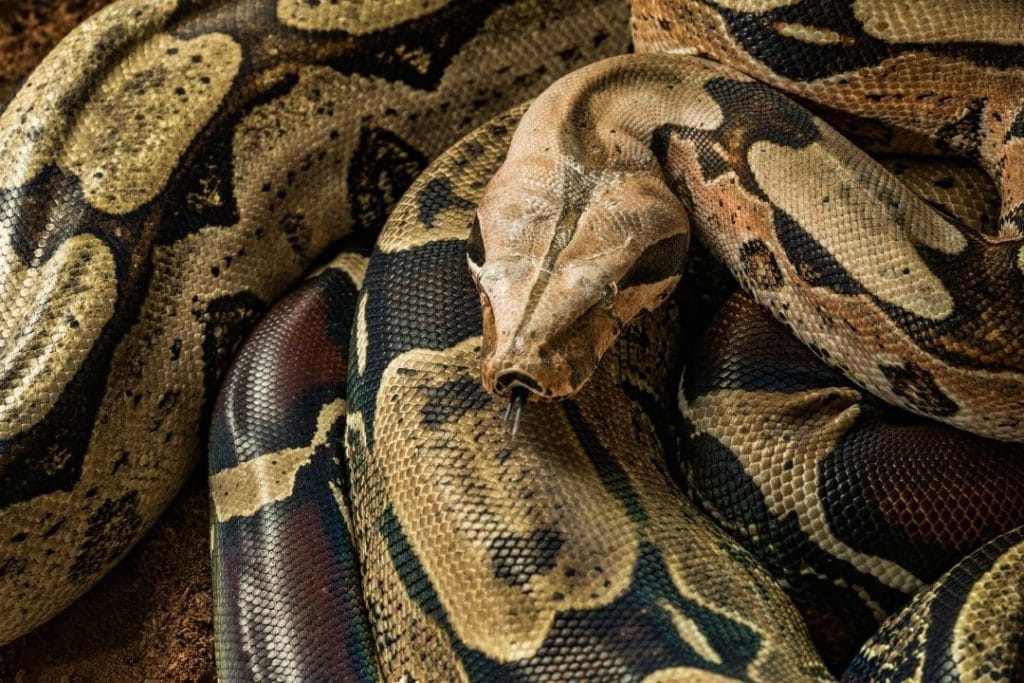
Larger subspecies and large females will need more space. This is where a custom enclosure or DIY will help. Custom caging fit for large snakes can be very expensive, so building it yourself is a good option if you are worried about the cost.
Just be sure you pick materials that can stand humidity or coat any wood to protect it. If your pet boa constrictor grows to over 8 feet, you will need around 8 feet by 4 feet by 4 feet as the minimum size.
If you do not have the space, consider a smaller species of snake like a ball python. Most boas are heavy, large snakes which will require an equally large enclosure.
Substrate
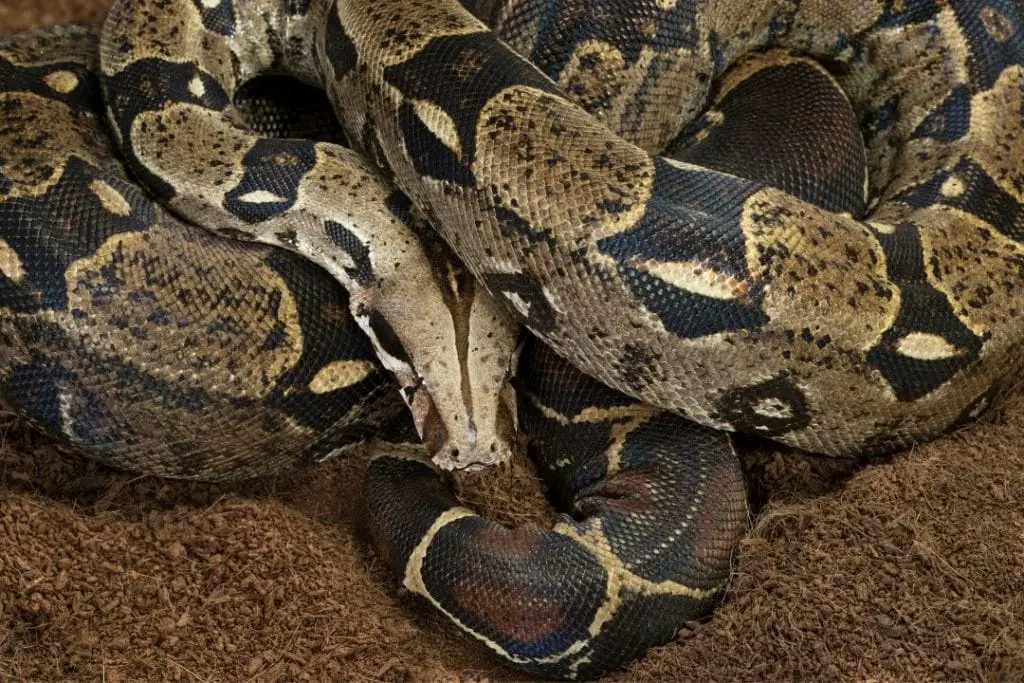
Boa constrictor substrate needs to handle high humidity and temperature. You should also pick something that has a low risk of inaction and holds burrows well. These snakes like to burrow, so you will need at least 3 inches of substrate.
Coconut fiber bedding like Eco Earth is a great option for boas. Go for a bio-active soil if you want a bio-active set-up, or a mix including topsoil if you intend to plant the enclosure.
Other good options and common boa substrates include Reptichip and cypress mulch. Both work well and hold humidity, but these can cause impaction in young boas if you aren’t very careful at feeding time.
Never use any wood like pine or cedar for reptile bedding or reptile carpet for boa constrictors. You can use paper like paper towels if you need to quarantine your snake, but they don’t hold humidity well and do not allow for burrowing.
Heating
Boa constrictors rely on ambient air temperature to raise their internal temperature. You need to offer a thermal gradient to allow your snake to regulate its temperature as needed.
What is the right temperature for a boa constrictor enclosure?
The hot side in a boa constrictor imperator enclosure should be between 86 and 90 degrees Fahrenheit. The cool side should be 75-80 degrees during the day. At night, you can let the air temperature drop to 68 at the lowest.
However, B. c. orophias and B. c. nebulosa may need to stay at 80 degrees no matter the time of day.
Heat should be provided with a ceramic heat bulb in a dome or with a radiant heat panel.
Undertank heating like heat pads usually doesn’t reach through the substrate layer well enough to heat a whole enclosure for a boa constrictor.
This is particularly true for taller enclosures. Hot rocks can help create a basking spot if needed.
Light
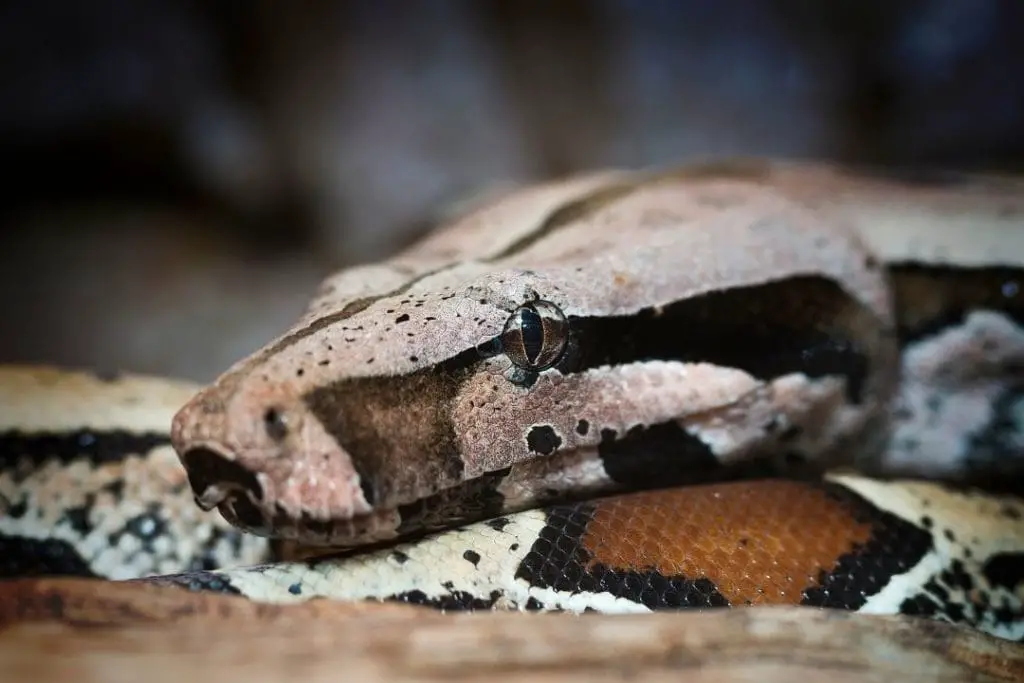
Do Boas need UVB light?
Generally speaking, boas do not need special lighting. Offering UVB in your boa’s enclosure may increase lifespan, so you can offer it above a basking spot on the warm side. If you decide to offer UVB, be sure you replace the bulb every year.
Otherwise, any basking light can be used. Use 11 hours on in the winter, 12 hours on in the spring and fall, and 13 hours on during the summer.
Never use any kind of lighting during the night since these snakes are nocturnal.
Shelter
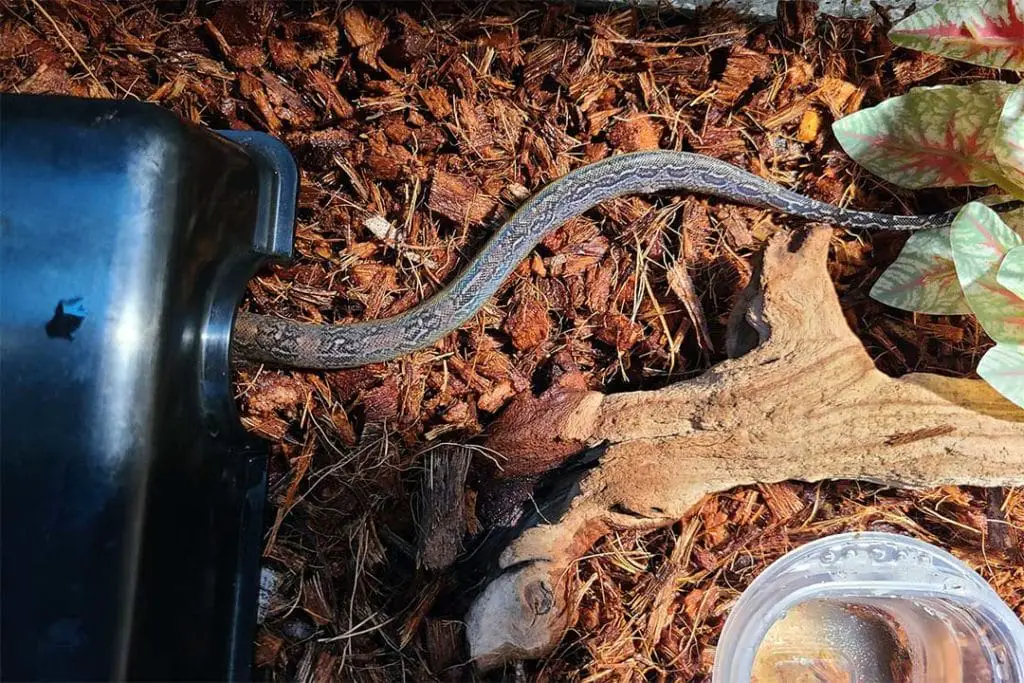
Boa constrictors need to feel secure. You should offer as many options to hide as possible. Use greenery to make a few perches feel more hidden.
Use leaves, sphagnum moss, and pieces of bark on the substrate to offer more hides.
Two proper hides that can hold the whole snake should be placed on each side of the enclosure (cool end and warm side). Make sure your snake has plenty of hides so it doesn’t need to choose between the right temperature for comfort and feeling safe.
Water
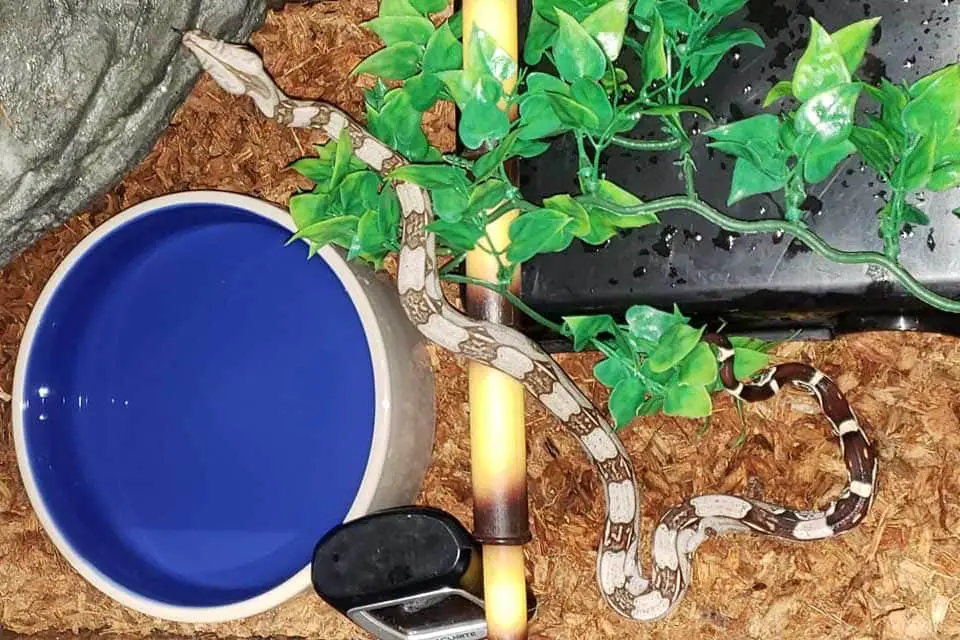
All snakes need access to fresh water for drinking and soaking. Your snake should be able to fit its whole body inside the water dish if it wants to soak.
A wider and shallower dish is typically preferred. This is very true of young snakes that may drown in a deeper dish. This is a nice option for a young snake.
Humidity
What is the right humidity for a boa constrictor ?
Humidity for a boa constrictor enclosure needs to be between 50 and 75%. It can go a bit higher right after a misting. Make sure your enclosure has a chance to dry out between mistings so you don’t risk the development of mold.
Measure it with a digital hygrometer. The analog type found in most pet stores is not accurate. You should offer damp sphagnum moss in a humid hide to help encourage healthy shedding.
Enclosure Maintenance
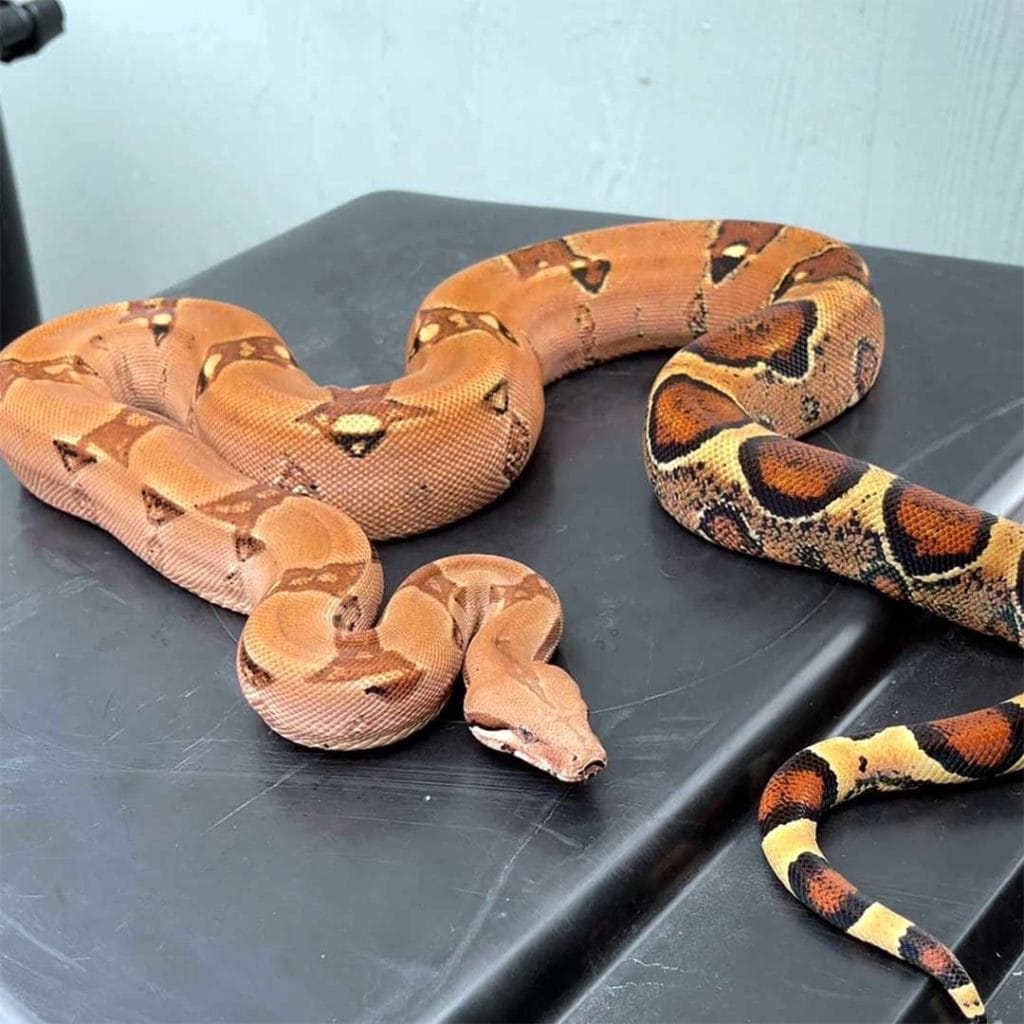
You should be spot cleaning every day. Check for urates or feces and remove them along with any soiled bedding. Be sure to replace it. You should also fill the water dish daily.
Every week, be sure to clean the water dish in your boa constrictor housing. Every 3 months you should do a deep clean. This involves removing all decorations and sanitizing the entire enclosure.
The substrate should be removed and thrown away. All of the furniture and the enclosure should be scrubbed with a reptile-safe sanitizer.
Be sure to rinse and air out the enclosure thoroughly so any fumes don’t harm your snake. This is a great time to redecorate to give your snake something new to explore.
Feeding
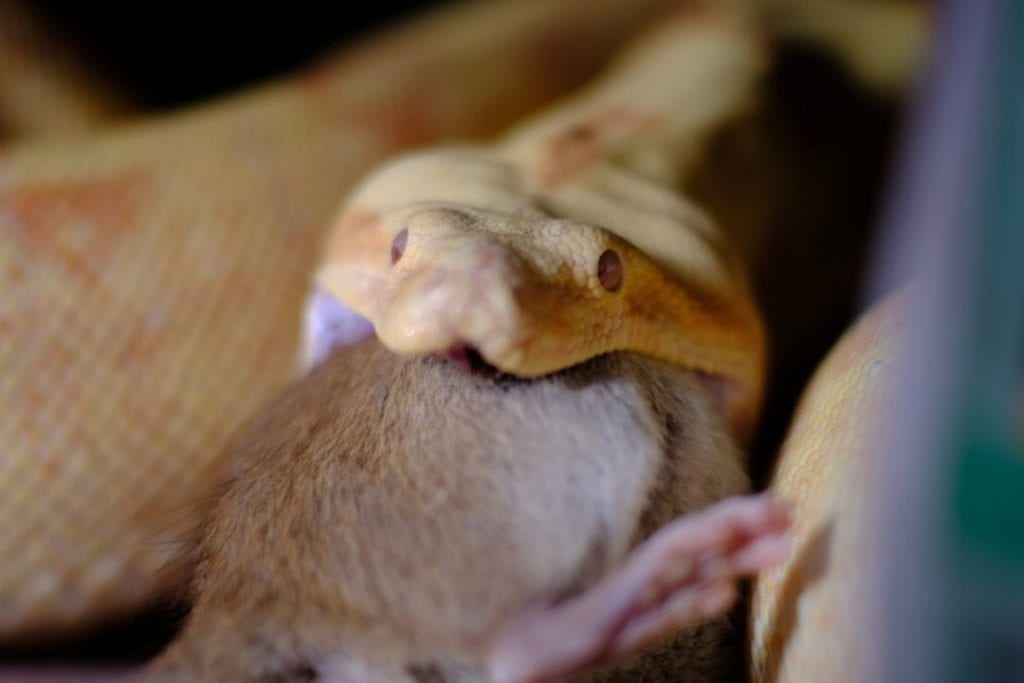
In the wild, boa constrictors will eat absolutely anything that will fit in its mouth. They eat rodents, birds, and have even been reported as eating arboreal monkeys.
Even in captivity, they tend to have a very strong defying response. These snakes will constrict anything they strike when they are hungry.
This means that your arm could be squeezed by a hungry snake. Always use feeding tongs and have a helper once your snake starts approaching adulthood at 6 years.
Type and Size of Prey
What size of mouse or rat should you feed?
Boa Constrictors will take any rodent or bird prey. Make sure you weigh your snake and feed it prey that weighs 10% of its body weight. A 10 pound snake will eat a 1 pound prey item.
Boas are not able to eat very large prey like pythons. They need smaller prey. For young snakes, mice or rats of appropriate size are perfect.
If you offer frozen mice, the weight of the prey is normally on the packaging. This makes picking the right size of prey pretty easy.
Weigh your snake in grams to make the math easier. Larger snakes may grow too large for rats as prey. At this point, you may want to look into young rabbits, guinea pigs, quail, and chickens for prey.
Only offer whole prey and make sure you do not offer live prey that can hurt your snake.
Frozen Vs Live
Many new keepers wonder if they should pick frozen or live prey. Live prey does allow for hunting behaviors, but it comes with a risk of injury or death for your pet. You also need to find and care for live prey until mealtime.
For small rodents, this isn’t so bad. However, larger prey like rabbits can be harder to keep. You also need to watch the entire feeding to make sure your snake isn’t hurt by prey fighting back.
Aadult rats are infamous for maiming and killing snakes.
Frozen prey can be bought ahead of time and you will know exactly what weight you are feeding your pet. All you need to do for frozen prey is to place it in the fridge a day before you want to feed your snake.
Then you can place the prey in a bag and heat it to body temperature in warm water. Some snakes do refuse frozen prey, but most will take it.
Some boa constrictors will also take Reptilinks, which are sausages made from ground-up whole prey. If your snake accepts them, this can be a great way to keep your pet fed.
Live prey can only be found in person. Frozen prey can be bought online or found at local pet stores. Be sure not to buy frozen prey from the large chain pet stores. Their rodent source has caused illness for snakes due to low quality.
How Often to Feed
How often does a boa constrictor eat?
Boa constrictors need to feed very rarely. Up until 12 months of age, they only eat every 10-12 days. Snakes that are between 12 and 18 months eat every 12-14 days. This shifts to every 2-3 weeks for snakes between 18 and 24 months.
Snakes that are 2-2.5 years old also eat every 2-3 weeks. 2.5-3-year-old boa constrictors eat every 3-4 weeks. 3-4-year-olds eat every 4-6 weeks. Snakes over 4 years old eat every 4-8 weeks.
As your snake grows they will eat less often.
The exact timing that will work for your snake depends on its metabolism. Different snakes have different needs. Watch your snake’s growth and its body condition.
The ideal shape for a boa constrictor is a square. If the spine seems prominent or you can see the ribs, your snake needs more frequent feedings. If your snake is round or has rolls, it is getting fat and needs less food.
Boas can go on feeding strikes and can stay long times without food.
Shedding
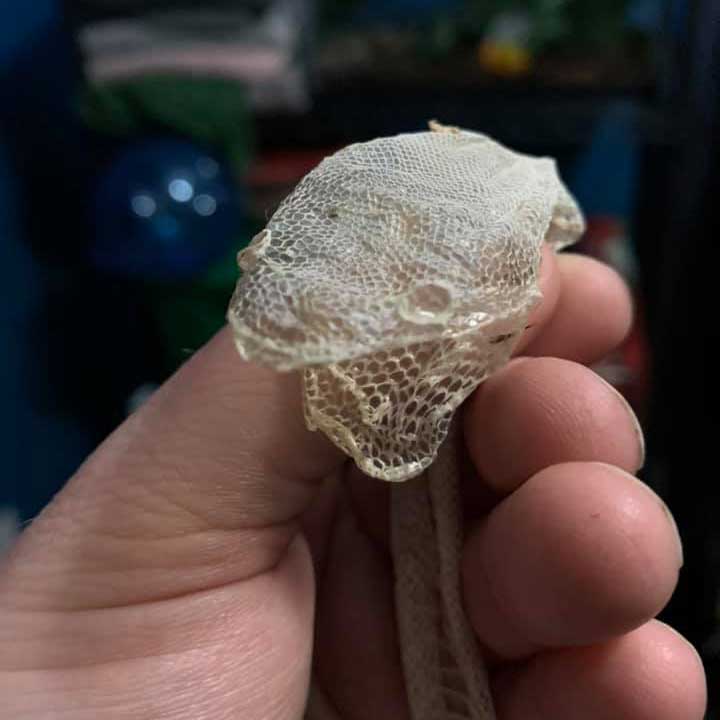
Shedding is very important for your boa constrictor. Shedding allows the snake to grow longer, prevents scale wear, and helps them heal.
A healthy shed will come off in one piece, including the tail tip and eye caps. When your snake is preparing to shed, you will see its eyes become cloudy and for the color to dull.
This is caused by the fluid build-up that allows for the layers of your snake’s skin to separate. You should bump the humidity up to between 75 and 80% humidity and provide a humid hide filled with damp sphagnum moss. Once your snake has shed, check the skin to make sure it came off in one piece.
If it is in pieces or parts are missing, check your per for signs of stuck shed. If you notice retained shed, you can place your snake in a tub filled with warm, damp paper towels.
Leave the snake in here for about 15 minutes and try to gently remove the stuck shed. Be gentle and don’t force it to come off. This can injure the snake. If your snake can’t get rid of the shed, it may be injured or suffer from an infection.
Hibernation
Red tail boas does not require any form of hibernation in the winter. Dropping temperatures to mimic the natural seasonal change can help signal to your snake that it is time to breed, but it is not needed for a captive animal.
Handling
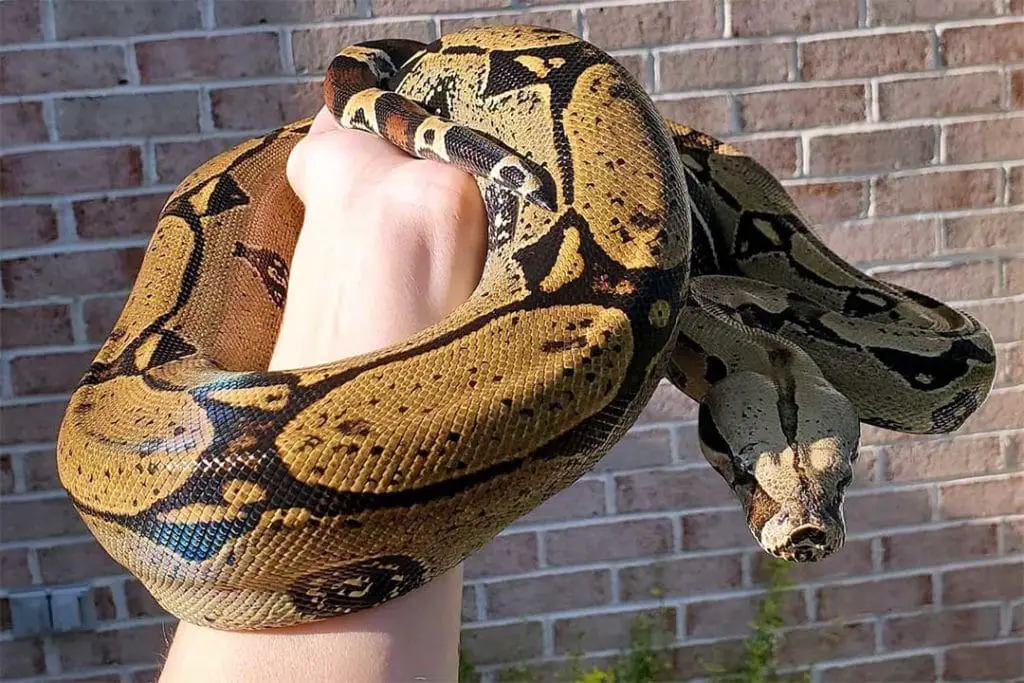
Boa constrictors require at least some training so they accept handling for essentials like cleaning and vet visits. Any snake that gets over 6 feet will require a helper no matter how friendly the snake typically is. This is because it can be hard for one person to remove the snake if it bites or constricts.
While they aren’t dangerous, these are still large animals that need to be respected. Your snake may enjoy being handled every day, while another snake may prefer being a display snake.
Juveniles are often defensive, will commonly strike and hiss
For babies, you need to handle them even if they try to hiss at you. Most hissing in young snakes is because they still don’t know you won’t hurt them. For an adult, accept that the snake wants to be left alone if it is hissing.
When you first get your snake, it is important to leave the snake alone for at least a week. Wait until your snake is eating regularly before you begin handling.
It is easier to start taming a baby or juvenile, but they do tend to strike more often. Adult snakes tend to have specific ideas on how much they want to be handled.
Start off with very short handling sessions. Stick with under 5 minutes at first. Use a snake hook to remove the snake from the enclosure.
Zoo Med Collapsible Snake Hook
- Adjustable from 7-1/4 to 26″ (18cm to 66cm)
- Allows you to manipulate your snake safely, or quickly inspect cage furnishings
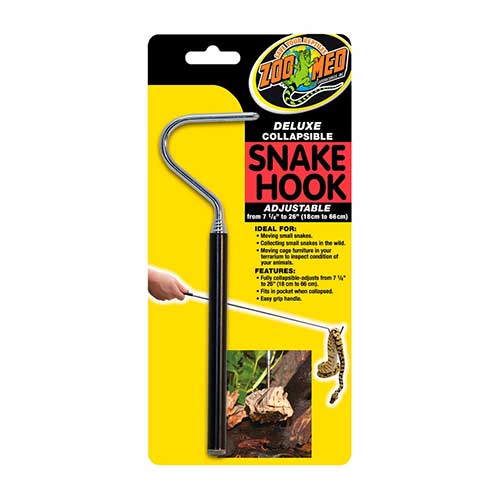
Tapping gently on the snake’s head with the hook allows it to learn that you are going to handle it rather than feeding it. Lift the snake out and allow it to rest on you.
It will wrap around you, but this is normal. So long as you do not smell like potential prey or a predator, your snake will view you as a weird tree. Make sure your snake is calm when you pick it up.
Look for slow respiration and tongue flicks. This means the snake is relaxed and curious. Fast respiration, rapid tongue flicks, and coiling into a defensive “S” all indicate that the snake may strike.
Gently guide the head of your snake away from your face and body. Allowing your snake to crawl anywhere on you when it is calm helps it learn that you are not a threat or food.
Do not ever grab your snake by the tail or restrain it. Picking up a snake by the tail can break bones or damage its spine. If you hurt it, the snake will always view you as a threat.
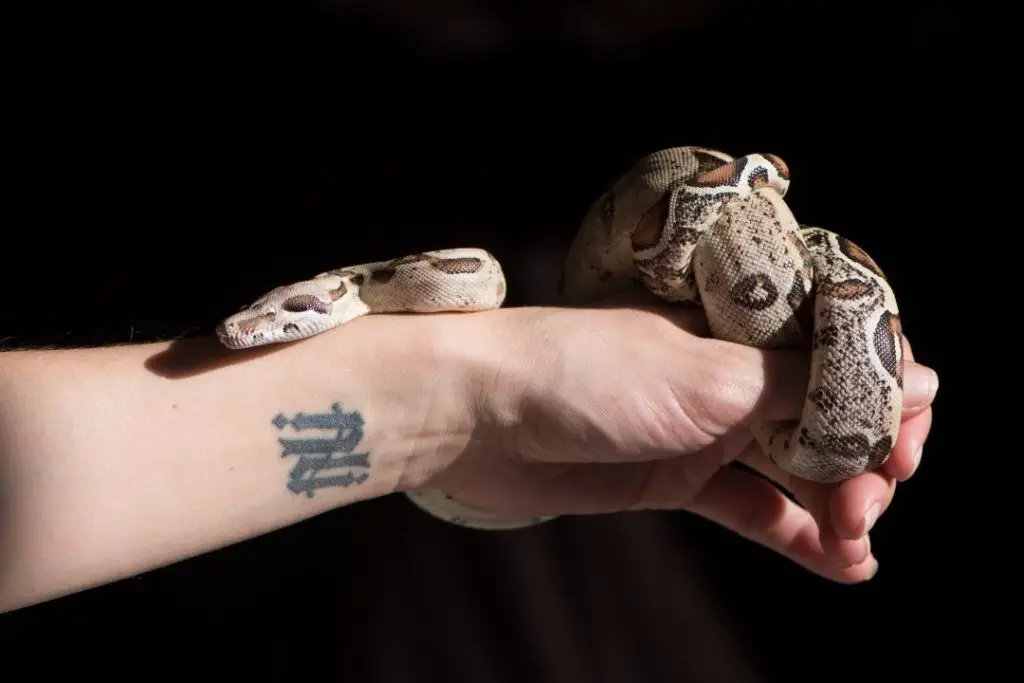
Try to avoid touching the head. Most snakes are nervous about its head being touching and may strike. When you have spent about 5 minutes with your snake, put it back in its enclosure.
Remember to end on a positive note. Do not put the snake back if it has bitten you or tried to urinate or defecate on you. The snake will learn that is how it makes you put it back.
Once the red tailed boa starts to become more comfortable, you can extend handling sessions to 10 minutes a few times a week. Your snake will show you how often it prefers to be handled by the time it reaches adulthood.
Some boas love the opportunity to exercise and will tolerate short handling sessions nearly every day. Other snakes prefer being left alone and should only be handled once a week.
Make sure you do not handle a snake when it is in shed, the same day you plan to feed it, and within 48 hours of a meal.
Common Issues
Boa constrictors have a few common concerns. Here are quick answers to these issues.
My Boa Constrictor Won’t Eat
Boa constrictors typically feed very well. However, they can stop eating due to stress or illness. Any changes in your household or their enclosure can make them refuse to eat.
Too much handling can stress them out, or when you are trying to switch a large adult to a different type of boa constrictor food. Illness and injury can also cause a loss of appetite.
If you notice any change to your snake like a change in color or strange noises while breathing, it can be inclusion body disease or another health issue. take your snake straight to the vet.
Common Health Issues
Respiratory illness, infection, inclusion body disease and injuries are the most common for snakes. Too much humidity or standing water can cause respiratory or skin infections.
Injuries from live prey or unsafe decoration can become infected if you do not catch them quickly. Parasites are also common. Have a fecal test done by your vet and watch for external parasites like mites and ticks.
Some boa constrictor morphs can be more sensitive than others.
Is My Boa Constrictor Dangerous
While boa constrictors are larger snakes, they are not any more dangerous than animals like dogs. The few cases of serious injury from boa constrictors were associated with neglected and abused animals.
A Boa constrictor imperator may decide smaller pets could be food, but even babies are too large for these snakes to eat. Keep other pets away from your snake, take care of it properly, and have an assistant when handling a snake longer than 6 feet.
Basic animal handling safety will prevent any dangerous situations. Captive boas are not aggressive, they only bite when defending themselves or trying to eat.
Sources
- Why We Were Totally Wrong About How Boa Constrictors Kill – National Geographics
- McGinnis, S.M. and Moore, R.G., 1969. Thermoregulation in the boa constrictor Boa constrictor. Herpetologica, 25(1), pp.38-45.
- Nathan, R., 2001. Captive Husbandry and Breeding of Boa Constrictors, Boa constrictor spp. Journal of Herpetological Medicine and Surgery, 11(2), pp.30-32.
- Warwick, C., Arena, P. and Steedman, C., 2019. Spatial considerations for captive snakes. Journal of veterinary behavior, 30, pp.37-48.
- Vancraeynest, D., Pasmans, F., Martel, A., Chiers, K., Meulemans, G., Mast, J., Zwart, P. and Ducatelle, R., 2006. Inclusion body disease in snakes: a review and description of three cases in boa constrictors in Belgium. Veterinary record, 158(22), pp.757-761.
Final Words
Boa constrictors are amazing snakes. Thanks to their size and space requirements, they are best kept by experienced keepers. Take good care of these snakes, and they will be with you for decades.
If you have any questions or comments on this boa constrictor care guide, please leave them below!
